
The biathlon is a winter sport that combines cross-country skiing and rifle shooting. It is treated as a race, with contestants skiing through a cross-country trail whose distance is divided into shooting rounds. The shooting rounds are not timed per se, but depending on the competition, missed shots result in extra distance or time being added to the contestant's total.

Orienteering is a group of sports that involve using a map and compass to navigate from point to point in diverse and usually unfamiliar terrain whilst moving at speed. Participants are given a topographical map, usually a specially prepared orienteering map, which they use to find control points. Originally a training exercise in land navigation for military officers, orienteering has developed many variations. Among these, the oldest and the most popular is foot orienteering. For the purposes of this article, foot orienteering serves as a point of departure for discussion of all other variations, but almost any sport that involves racing against a clock and requires navigation with a map is a type of orienteering.

Shooting sports is a group of competitive and recreational sporting activities involving proficiency tests of accuracy, precision and speed in shooting — the art of using ranged weapons, mainly small arms and bows/crossbows.

Ole Einar Bjørndalen is a retired Norwegian professional biathlete and coach, often referred to by the nickname, the "King of Biathlon". With 13 Winter Olympic Games medals, he is second on the list of multiple medalists behind Marit Bjørgen who has won 15 medals. He is also the most successful biathlete of all time at the Biathlon World Championships, having won 45 medals. With 95 World Cup wins, Bjørndalen is ranked first all-time for career victories on the Biathlon World Cup tour. He has won the Overall World Cup title six times, in 1997–98, in 2002–03, in 2004–05, in 2005–06, in 2007–08 and in 2008–09.
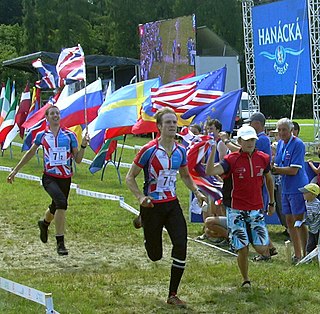
A relay race is a racing competition where members of a team take turns completing parts of racecourse or performing a certain action. Relay races take the form of professional races and amateur games. Relay races are common in running, orienteering, swimming, cross-country skiing, biathlon, or ice skating. In the Olympic Games, there are several types of relay races that are part of track and field. Relay race, also called Relay, is a track-and-field sport consisting of a set number of stages (legs), usually four, each leg run by different members of a team. The runner finishing one leg is usually required to pass the next runner a stick-like object known as a "baton" while both are running in a marked exchange zone. In most relays, team members cover equal distances: Olympic events for both men and women are the 400-metre and 1,600-metre relays. Some non-Olympic relays are held at distances of 800 m, 3,200 m, and 6,000 m. In the less frequently run medley relays, however, the athletes cover different distances in a prescribed order—as in a sprint medley of 200, 200, 400, 800 metres or a distance medley of 1,200, 400, 800, 1,600 metres.
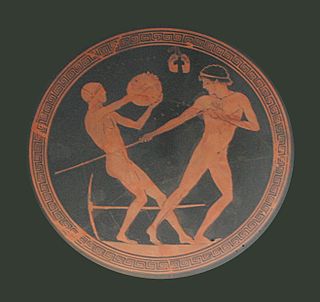
A pentathlon is a contest featuring five events. The name is derived from Greek: combining the words pente (five) and -athlon (competition). The first pentathlon was documented in Ancient Greece and was part of the Ancient Olympic Games. Five events were contested over one day for the Ancient Olympic pentathlon, starting with the long jump, javelin throwing, and discus throwing, followed by the stadion and wrestling. Pentathletes were considered to be among the most skilled athletes, and their training was often part of military service—each of the five events in the pentathlon was thought to be useful in war or battle.

The Union Internationale de Pentathlon Moderne, commonly known by the acronym UIPM, has been the international governing body of modern pentathlon since its foundation in London in 1948. Its headquarters are in Monte-Carlo, Monaco, and it has 115 national federation members. Modern pentathlon was introduced at the fifth Olympiad in Stockholm, Sweden, in 1912, comprising the contemporary sports of pistol shooting, fencing, swimming, horse riding and running, which embraced the spirit of its ancient counterpart.

Miriam Neureuther is a former German biathlete and cross-country skier. She has won an Olympic silver medal in cross-country skiing and two biathlon world championship titles, all in team events. Noted for her fast skiing performances, she won two junior world championship titles in biathlon in 2008 and 2009. Gössner was called up for the Nordic World Ski Championships 2009, where she was part of Germany's cross-country team claiming silver in the 4 × 5 kilometre relay.
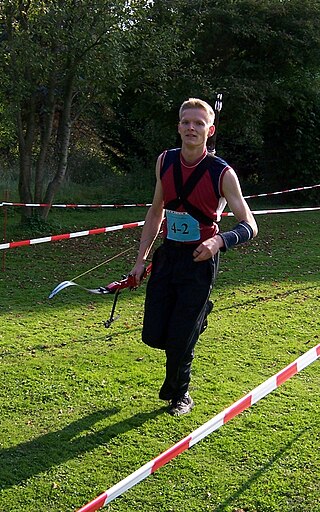
Run archery is a shooting discipline connecting archery with running. It is similar to the sport of biathlon.

In sport, score is a quantitative measure of the relative performance of opponents in a sporting discipline. Score is usually measured in the abstract unit of points, and events in the competition can raise or lower the score of the involved parties. Most games with score use it as a quantitative indicator of success in the game, and in competition, a goal is often made of attaining a better score than one's opponents in order to win.
Tim Robertson is a New Zealand orienteering competitor. He won the gold medal in the sprint course at the Junior World Orienteering Championships in 2014, and 2015.

Competitive cross-country skiing encompasses a variety of race formats and course lengths. Rules of cross-country skiing are sanctioned by the International Ski Federation and by various national organizations. International competitions include the FIS Nordic World Ski Championships, the FIS Cross-Country World Cup, and at the Winter Olympic Games. Such races occur over homologated, groomed courses designed to support classic (in-track) and freestyle events, where the skiers may employ skate skiing. It also encompasses cross-country ski marathon events, sanctioned by the Worldloppet Ski Federation, and cross-country ski orienteering events, sanctioned by the International Orienteering Federation. Related forms of competition are biathlon, where competitors race on cross-country skis and stop to shoot at targets with rifles, and paralympic cross-country skiing that allows athletes with disabilities to compete at cross-country skiing with adaptive equipment.

Felthurtigskyting, literally field-rapid-shooting, is a practical rifle competition popular in Scandinavia, where the shooter has to engage three different targets placed at different distances with one shot each in the shortest time possible.
The Target Sprint is a summer shooting sport discipline that combines running and air rifle shooting. It is treated as a race, with contestants running 3 x 400 meters with two 10m rifle shooting sessions in between. The shooting rounds are not timed per se, but missed shots result in time being added to the contestant's total. The athletic sports is run under ISSF
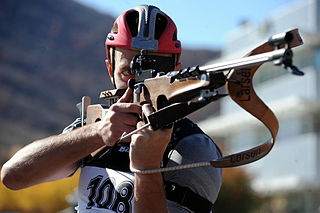
A Biathlon rifle is a specialized rifle designed for use in a biathlon event. Specialist biathlon rifles are ultra lightweight, and usually equipped with straight-pull actions, integrated magazine carriers, and ergonomic stock designs suitable for both prone and standing positions.
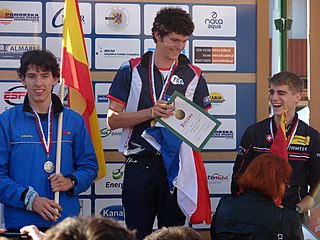
Andreu Blanes Reig is a Spanish orienteering competitor and long-distance runner. He was born in Onil. He won a silver medal in sprint at the 2011 Junior World Orienteering Championships, and placed fourth in the relay. He competed at the 2018 World Orienteering Championships in Latvia, where he placed seventh in the sprint final. He has competed in the 2011, 2012, 2013, 2014, 2015, 2016, 2017 and 2018 World Orienteering Championships. His best World Championship result before 2018 was a seventh place in the sprint at the 2015 World Orienteering Championships.
Moose biathlon is a winter sport variation of biathlon, which combines cross-country skiing, range estimation of paper targets resembling a moose, and rifle shooting using fullbore biathlon rifles. The Finnish Hunters' Association holds competitions, which were first developed in Finland in the 1970s. Today, competitions are held in Finland and Sweden with a goal of becoming a Nordic discipline. There are over 10,000 competitors in Sweden and Finland, with over 600 competitors participating in the yearly Finnish Championship.
Nordic field biathlon is a combined cross-country skiing and shooting sport discipline within Det frivillige Skyttervesen. The sport is considered a close predecessor to olympic biathlon, with the main difference being the use of fullbore biathlon rifles and paper targets placed in the terrain with time penalties added for misses. The skiing is usually performed in classic style, while freestyle on is permitted in some races. The number of shots and length of the skiing part can vary. Contrary to the other exercises in the organization, Nordic shooting with cross-country running and Nordic Field Biathlon competitors are divided into male and female competitive divisions.

Nordic shooting with cross-country running or running biathlon is a biathlon sport which combines running and shooting.
The 2019–20 Biathlon World Cup – Sprint Men started on 1 December 2019 in Östersund and was finished on 12 March 2020 in Kontiolahti.
















